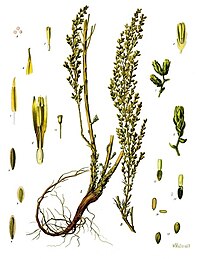
Photo from wikipedia
The monoterpene camphor is produced in glandular secretory trichomes of the medicinal plant Artemisia annua, which also produces the antimalarial drug artemisinin. We have found that, depending on growth conditions,… Click to show full abstract
The monoterpene camphor is produced in glandular secretory trichomes of the medicinal plant Artemisia annua, which also produces the antimalarial drug artemisinin. We have found that, depending on growth conditions, camphor can accumulate at levels ranging from 1- 10% leaf dry weight (LDW) in the Artemis F1 hybrid, which has been developed for commercial production of artemisinin at up to 1% LDW. We discovered that a camphor null (camphor-0) phenotype segregates in the progeny of self-pollinated Artemis material. Camphor-0 plants also show reduced levels of other less abundant monoterpenes and increased levels of the sesquiterpene precursor farnesyl pyrophosphate plus sesquiterpenes, including enzymatically derived artemisinin pathway intermediates but not artemisinin. One possible explanation for this is that high camphor concentrations in the glandular secretory trichomes play an important role in generating the hydrophobic conditions required for the non-enzymatic conversion of dihydroartemisinic acid tertiary hydroperoxide to artemisinin. We established that the camphor-0 phenotype associates with a genomic deletion that results in loss of a Bornyl diPhosphate Synthase (AaBPS) gene candidate. Functional characterization of the corresponding enzyme in vitro confirmed it can catalyze the first committed step in not only camphor biosynthesis but also in a number of other monoterpenes, accounting for over 60% of total volatiles in A. annua leaves. This in vitro analysis is consistent with loss of monoterpenes in camphor-0 plants. The AaBPS promoter drives high reporter gene expression in A. annua glandular secretory trichomes of juvenile leaves with expression shifting to non-glandular trichomes in mature leaves, which is consistent with AaBPS transcript abundance.
Journal Title: Frontiers in Plant Science
Year Published: 2022
Link to full text (if available)
Share on Social Media: Sign Up to like & get
recommendations!